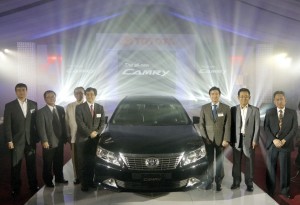First impressions count a lot, especially before you get to test-drive the newest full-model change of a best-seller like the Toyota Camry. The 2012 or seventh generation of Toyota’s flagship sedan was unveiled in Manila last week by Toyota Motor Philippines (TMP) with a lot of fanfare and celebration.
TMP has reason to celebrate. In the Philippines, the Camry leads in the midsize executive sedan segment, outselling the competition as evidenced by the number of Camrys of various model years seen on the road compared to rivals such as the Honda Accord, Mitsubishi Galant, Nissan Teana and Mazda6.
Remember that Toyota Motor Corp. Japan developed the Camry in 1983 primarily to grab market share from the Accord in the lucrative North American market. The Camry succeeded in its mission. For the last nine years, the Camry has outsold all other passenger cars in the United States. Now comes the 2012 model to continue its leadership tradition.
Since I have yet to test-drive the new Camry, I cannot comment on its performance and will limit myself to impressions about its exterior and interior design. From the start, the Camry has had a conservative, mainstream design philosophy, not unattractive but not stylish enough to turn heads, either. So I wasn’t surprised that the seventh generation has the same proportions and looks similar to the outgoing model.
TMP points out that the new Camry’s sweeping headlights, horizontal chrome grill and triangular fog lamps resemble the Lexus IS, the entry-level small sedan of Toyota’s premium brand. Design cues from Lexus are nice, but not really necessary for the Camry to continue being a phenomenal success. The 2012 Camry looks as solid as its sterling reputation, earned through the years, for reliability, durability, comfort, impeccable finish and a high standard of quality.
DANNY Isla, now the top guy at Lexus, helped steer the Camry to great heights when still with Toyota.
The Camry’s rear end has been redesigned with new, larger taillights. Inside, there seems to be more leg and head room in the back. In the top-of-the-line 3.5Q V6 model (268 hp, 248 lb-ft max torque, retail price P2.082 million), the leather-wrapped steering wheel has wood grain, there is a multi-information display with touch-screen audio display, a 3-zone temperature control system for the driver, front seat and back seat separately, a back-up camera, pushbutton Smart Entry and Start System, and Nano-E technology that cleans the air inside the cabin by preventing the absorption of mold, fungus and dust. Whether all these technologies work well and/or are easy to operate remains to be seen during a test drive.
All the Camry variants—the 3.5Q, 2.5V (P1.681 million) and 2.5G (P1.451 million)—have leather seats and a 6-speed sequential transmission with Super ECT. The 2.5 liter, 4-cylinder variants produce 178 hp and 190 lb-ft max torque. By the way, the white pearl units cost P15,000 more.
Certainly, it’s not because of its bland exterior design that so many motorists remain loyal to the Camry and keep on buying it, model change after model change. Stay tuned for the explanation.
